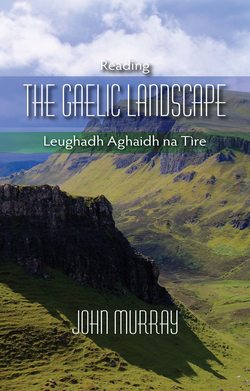Читать книгу Reading the Gaelic Landscape - John Murray - Страница 16
На сайте Литреса книга снята с продажи.
4.4: The Genitive Case - singular and plural
ОглавлениеThe possessive or genitive case is common in place-name constructions. Like adjectives, it gives greater specificity to nouns. Knowing the effect of the genitive on noun form in both singular and plural is essential for interpretation of place-names. It is necessary to see what may be familiar words in their nominative, in their genitive case. Changes made to articles differ according to gender, what letter a noun begins with, whether nouns are singular or plural and articles definite or indefinite ie. absent.
Two earlier examples, which show the most regular form of the genitive will be quoted. Cladach and cruach are masculine and feminine respectively. With definite articles, in the genitive and coupled with ceann, they are ceann a’ chladaich (cyown uh CHLAteech) and ceann na cruaiche (cyown nuh CROOeechuh). Notice how the masculine noun is aspirated by the article a’, and its final syllable is slenderised from A to AI with a slenderisation of pronunciation resulting. Notice also how the feminine article becomes na, and does not cause lenition, and how the second syllable of cruach slenderises. Cruach also gains a third syllable, which forms an E ending. For feminine nouns beginning with a vowel the article becomes na h-; as in Cnoc na h-Eaglaise - The Hillock of the Church. (Note that na h- is the same for both genders in nominative plurals before a vowel).
Generally articles applying to masculine nouns in the genitive become similar to feminine nouns in the nominative. So, a’ applies to lenitable words like cladach, whilst an applies to non-lenitable nouns like lochan (small loch) and nouns beginning with a vowel like allt. The latter gives us Taigh an Uillt (Tie un Ooltch) - Taynuilt. An t- applies to nouns beginning with an S, like sruth (sroo), meaning a current or stream, giving Creag an t-Sruith (crayk un TROOee), Strathyre. Here, after heavy rain, a jet of water runs down the face of a large boulder.
Table 3: The Gaelic Definite Article - Nominative and Genitive Forms.
As we have seen, slenderisation caused by the genitive case can change whole syllables. So binnean (BINyan), masculine, meaning high conical hill, becomes binnein (BINyane) and bidean (BEEtchan), also masculine, meaning pinnacle or high, pointed hill becomes bidein (BEETchane). The more common ceann becomes cinn (keen) in the genitive, identical to its plural. Similarly, toll (towl) - hole (masculine), becomes (Clach an) Tuill - tooeel, in the genitive - again the same as the its plural. An tom (towm) - knoll (masculine), becomes (Baile an Tuim) - TOOim. But its plural is toman or tomannan.
Table 4: Nominative and Genitive Nouns with a One Syllable Adjective
There are exceptions to the rules. The genitive of srath is sratha. For druim (DROYim) it is droma, giving Taigh an Droma / Tyndrum - The House of the Ridge. The genitive of am bràigh, despite being masculine, can be a’ bhràighe or a’ bhràghad (uh VRAAut). Although tràigh (try), meaning beach, is feminine, it has a similar genitive to bràigh, which is tràghad (TRAut). Càrn can be càirn or cùirn in the genitive - the same as its plural.
The logic governing genitive nouns without an article in singular and plural forms is harder to fathom. In the genitive, indefinite singular, masculine nouns lose the lenition of the genitive, definite singular, but otherwise remain the same, whilst feminine nouns are wholly unchanged. So our examples of cladach and cruach become cladaich and cruaiche respectively. Proper names are an exception to this rule, so Calum’s Mountain is Beinn Chaluim.
In the genitive, indefinite plural masculine nouns revert, as in the definite plural, to the singular nominative, but in contrast to that, they lenite where possible. Feminine nouns in the genitive, indefinite plural both lenite, where possible, and take the plural form. So our examples become chladach and chruachan. The way in which one syllable adjectives agree with nouns in the genitive is shown in Table 4.
Plural genitives, like plural nominatives, are easier, because nouns usually retain their form in the singular. Their article is either nan or nam before a B, F, M, or P. As masculine and feminine forms are identical, it is the learner’s favourite case. Bealach nan Corp NN556109 ( BYAluch nun corp) - The Pass of the Bodies, north of Ben Ledi, and Sgùrr nan Gillean (skoor nun GEELyun) at NG472253 - The Peak of the Boys in the Cuillins of Skye, are masculine. Coire nan Saighead at NN606157 (CAWryuh nun SYut) - The Corrie of the Arrows, Sgiath nam Mucan Dubha at NN497074 (SGEEuh num MOOchkun DOOah) - The Wing-shaped Hill of the Little Black Pigs in the Trossachs are feminine. Here the suffix an applyied to muc denotes the diminutive - little. For if the pigs had been of a normal size, muc would remain in its singular form. So, nam mucan in this context means; of the little pigs. Many monosyllabic adjectives like àrd - high, and mòr - big, behave in the same way as dubh in the plural, resulting in beanntan àrda and gleanntan mòra. Also note how it is not possible to distinguish The Corrie of the Arrows from Corrie of the Arrows.
